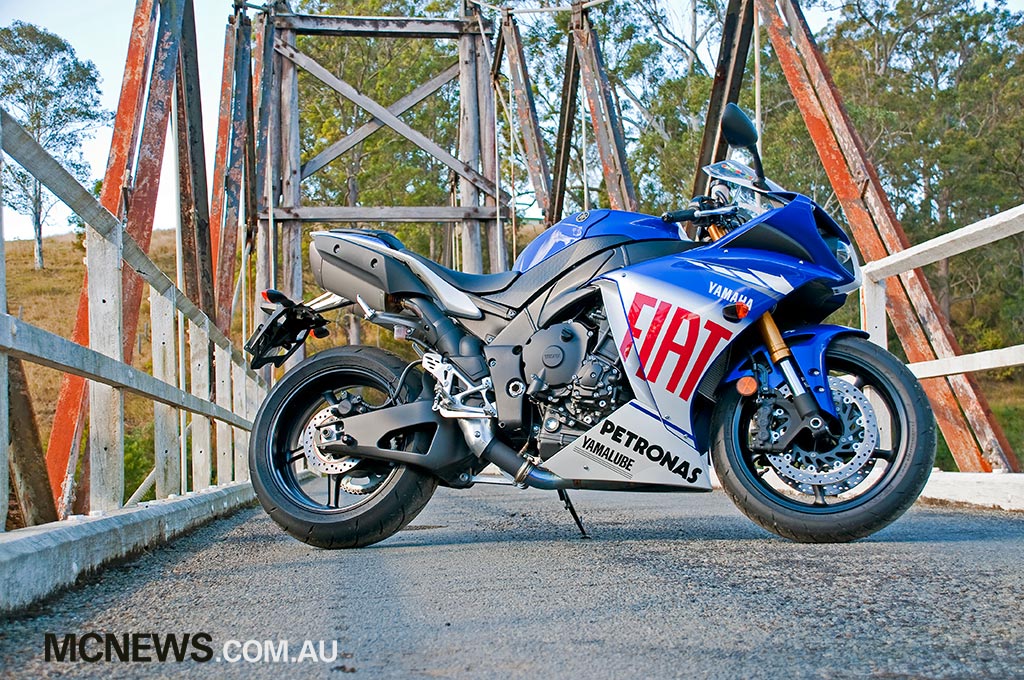The sportsbike world changed forever in 1998 when Yamaha launched the revolutionary YZF-R1. Its sharp angular lines hinted at the bad boy within but nothing prepared you for the first ride aboard Yamaha’s new sportsbike flagship way back in the day. While the claimed 150hp lurking inside that first R1 is hardly notable some 12 years later, back in its day that original R1 was simply astonishing. The power hit so hard in the mid-range that it was virtually impossible to keep the front wheel on the ground as the chassis components of the day struggled to make effective use of that power. It was an animal and made the R1 an instant legend of motorcycling.
Today’s R1 is the complete package and is perhaps the least outright sports focussed R1 Yamaha has yet produced. Instead it is an utterly brilliant road-going sportsbike possessed of great manners, fine character and is a class act.
Last year Yamaha introduced an innovative cross-plane crankshaft design which completely changed the characteristics of the engine and gave the R1 something truly unique.
The wailing top end power of a four-cylinder married to a beat and tune more reminiscent of a sporting twin produces an evocative note and feel that makes every ride an extravaganza for the senses.
It doesn’t hit as hard in the mid-range as a Fireblade, or have the stratospheric top end of BMW’s S1000RR but I couldn’t care less. Never before has an engine delivered so much character in such a smooth fashion. Prior to the cross-plane R1 those traits were mutually exclusive thus Yamaha have broken new ground with this innovative engine design. And I love it.
There is no traction control function on the R1 but the rider can switch through three different engine maps; a great all-round delivery in STD mode, A mode delivers crisper and more aggressive response while B mode softens rider inputs to make the bike more manageable in slippery conditions or city traffic.
The R1’s electronics suite features a fly-by-wire throttle which controls the angle of the throttle butterflies, timing of the eight injectors and position of the variable length intake runners to maximise performance. Despite all the electronics the throttle action feels nice and not at all disconnected in the way some fly by wire throttles can be and is also much smoother on pick up out of a turn than the R6.
On the street the R1 is sure-footed, stable and deals with bumps quite well. The R1 suspenders are tuned for the street and it shows. For serious racetrack action the standard suspension quickly progresses outside of its comfort zone and trackday junkies will want to head to their favourite suspension fettler for valving and spring changes in order to get the best out of the R1. The suspension components are all top shelf but in maximum attack track mode don’t inspire as much confidence as its rivals. It also seems to eat rear tyres at an alarming rate.
Ergonomically the R1 offers a spacious cockpit compared to its contemporaries. The controls fall easily to hand and the throttle, brake and clutch levers all feel just right and made me feel right at home straight away. It’s comfortable enough for full days in the saddle and normal riding returns six litres per 100km. The fuel light comes on after 225km to indicate there is 3.5 litres remaining in the 18 litre tank making for a handy 280km range.
The latest R1 is a class act. At the track it does now fall a little short compared to its contemporaries thus if you are a card carrying trackday junkie that likes to push hard then perhaps the R1 is not for you. On the road however the R1 offers plenty of performance and most will run out of talent before the R1 gets flustered and once you’ve sampled that engine you can forgive it almost anything.
Never before has a big bore four provided such a visceral experience. The R1 makes every ride a soul stirring experience while somehow still remaining smooth and accessible.
The standard blue, white or black colour scheme R1s retail for $19,999 plus on road costs while a special limited edition version of the R1 painted in Valentino Rossi’s Fiat Yamaha livery commands a $1300 premium over the standard model. And with Valentino moving to Ducati there will never be another Rossi replica R1, so I would suggest getting in quick.

- Seat Height – 835mm
- Wheelbase – 1415mm
- L x W x H – 2070 x 715 x 1130mm
- Wet Weight – 206kg
- Fuel Capacity – 18 Litres
- Average Consumption on test – 6.5 litres per 100km
- Range – 280km
- Warranty – Two years
- Price – Expect to pay around $19,999 for standard colours or $21,299 for the Valentino Rossi liveried special edition plus applicable stamp duties and registration chargesVerdict – ****Positives
+ Engine provides pleasure to all senses
+ Ergonomics (for a sportsbike)Negatives
– Suspension needs fettling for track use
– Higher price than Japanese sportsbike rivals























